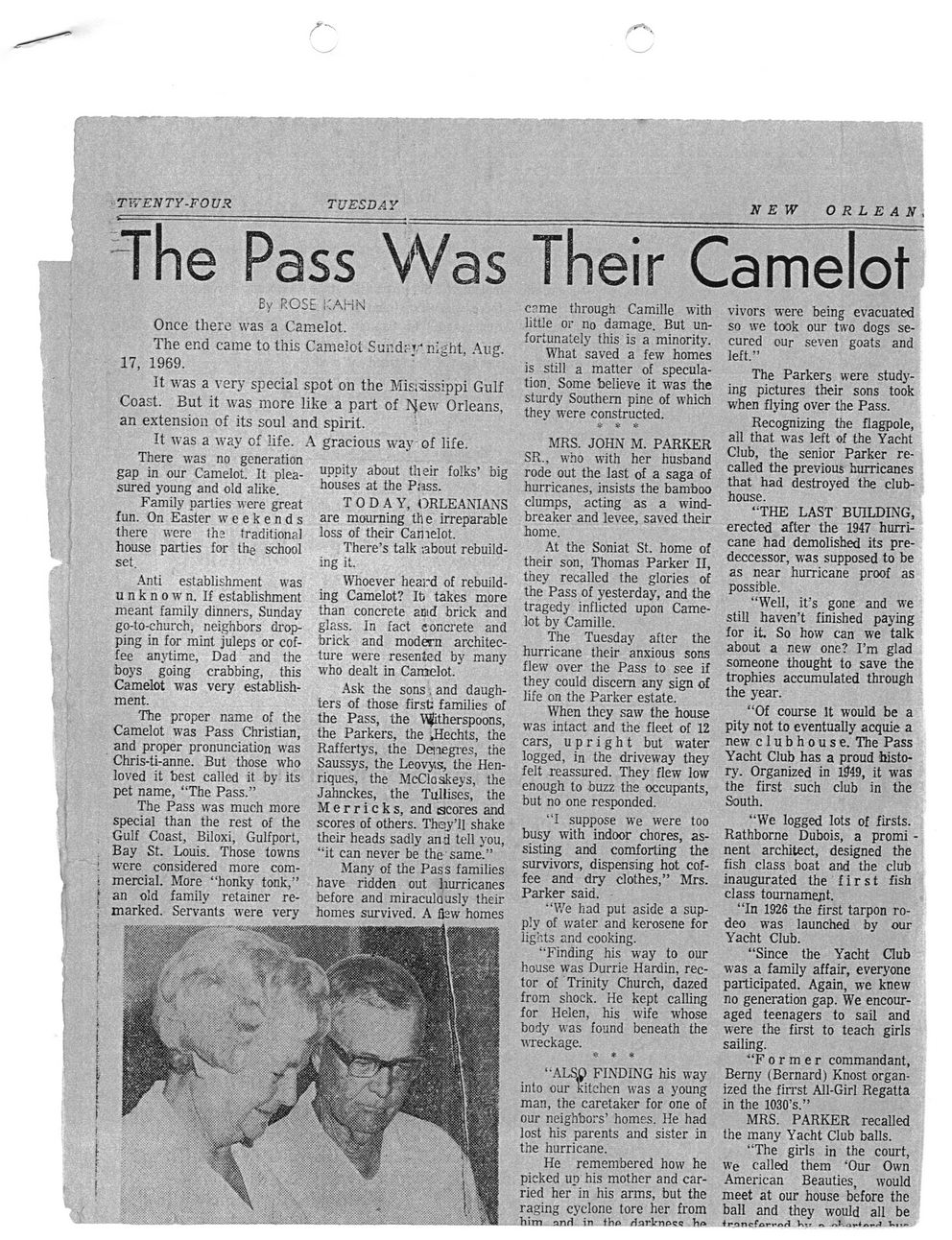This text was obtained via automated optical character recognition.
It has not been edited and may therefore contain several errors.
TWENTY-FOUR TUESDAY NEW ORLEA N , The Pass Was Their Camelot By ROSE KAHN Once there was a Camelot. The end came to this Camelot Sund;-t- night, Aug. 17, 1969. It was a very special spot on the Mis;?issippi Gulf Coast. But it was more like a part of I^ew Orleans, an extension of its soul and spirit. It was a way of life. A gracious way of life. There was no generation uppity about their folks’ big houses at the Pass. TODAY, ORLEANIANS are mourning the irreparable loss of their Camelot. There’s talk about rebuilding it. Whoever heard of rebuilding Camelot? Itj takes more than concrete amd brick and glass. In fact concrete and brick and modern architecture were resented by many who dealt in Camelot. Ask the sons, and daughters of those first: families of the Pass, the Witherspoons, the Parkers, the JHechts, the Raffertys, the Demegres, the Saussys, the Leovy.s, the Hen-riques, the McCloskeys, the Jahnckes, the Tullises, the M e r r i c k s, and scores and scores of others. Thay’ll shake their heads sadly and tell you, “it can never be the same.” Many of the Pass families have ridden out hurricanes before and miraculously their homes survived. A flaw homes no gap in our Camelot. It pleasured young and old alike. Family parties were great fun. On Easter weekends there were 1h2 traditional house parties for the school set. Anti establishment was unknown. If establishment meant family dinners, Sunday go-to-church, neighbors dropping in for mint juleps or coffee anytime, Dad and the boys going crabbing, this Camelot was very establishment. The proper name of the Camelot was Pass Christian, and proper pronunciation was Chris-ti-anne. But those who loved it best called it by its pet name, “The Pass.” The Pass was much more special than the rest of the Gulf Coast, Biloxi, Gulfport, Bay St. Louis. Those towns were considered more commercial. More “honky tonk,” an old family retainer remarked. Servants were very cnme through Camille with little or no damage. But unfortunately this is a minority. What saved a few homes is still a matter of speculation. Some believe it was the sturdy Southern pine of which they were constructed. * * * MRS. JOHN M. PARKER SR., who with her husband rode out the last of a saga of hurricanes, insists the bamboo clumps, acting as a wind-breaker and levee, saved their home. At the Soniat St. home of their son, Thomas Parker II, they recalled the glories of the Pass of yesterday, and the tragedy inflicted upon Camelot by Camille. The Tuesday after the hurricane their anxious sons flew over the Pass to see if they could discern any sign of life on the Parker estate. When they saw the house was intact and the fleet of 12 cars, upright but water logged, in the driveway they felt reassured. They flew low enough to buzz the occupants, but no one responded. “I suppose we were too busy with indoor chores, assisting and comforting the survivors, dispensing hot coffee and dry clothes,” Mrs. Parker said. “We had put aside a supply of water and kerosene for lights and cooking. “Finding his way to our house was Durrie Hardin, rector of Trinity Church, dazed from shock. He kept calling for Helen, his wife whose body was found beneath the wreckage. * * * “ALSO FINDING his way into our kitchen was a young man, the caretaker for one of our neighbors’ homes. He had lost his parents and sister in the hurricane. He remembered how he picked up his mother and carried her in his arms, but the raging cyclone tore her from him anri in thA Harlrnpcc vivors were being evacuated so we took our two dogs secured our seven goats and left.” The Parkers were studying pictures their sons took when flying over the Pass. Recognizing the flagpole, all that was left of the Yacht Club, the senior Parker recalled the previous hurricanes that had destroyed the clubhouse. “THE LAST BUILDING, erected after the 1947 hurricane had demolished its pre-deccessor, was supposed to be as near hurricane proof as possible. “Well, it’s gone and we still haven’t finished paying for it. So how can we talk about a new one? I’m glad someone thought to save the trophies accumulated through the year. “Of course lt would be a pity not to eventually acquie a new clubhouse. The Pass Yacht Club has a proud history. Organized in 1049, it was the first such club in the South. “We logged lots of firsts. Rathborne Dubois, a promi -nent architect, designed the fish class boat and the club inaugurated the first fish class tournament. “In 1926 the first tarpon rodeo was launched by our Yacht Club. “Since the Yacht Club was a family affair, everyone participated. Again, we knew no generation gap. We encouraged teenagers to sail and were the first to teach girls sailing. “Former commandant, Berny (Bernard) Knost organized the firrst All-Girl Regatta in the 1030’s.” MRS. PARKER recalled the many Yacht Club balls. “The girls in the court, we called them ‘Our Own American Beauties, would meet at our house before the ball and they would all be

Hurricane Camille Camille-Aftermath-Media (144)